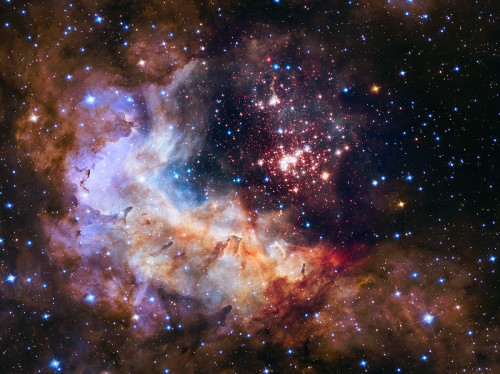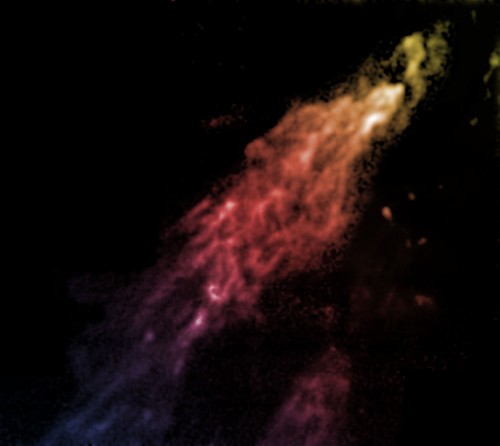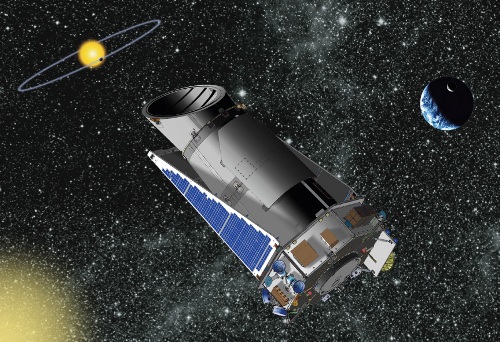Tag archives: Hubble Space Telescope
Jupiter roars as Juno approaches, a huge helium discovery and all you need to know about dark matter
By Hamish Johnston
Early next week NASA’s Juno spacecraft will fire its blasters and pop itself into orbit around Jupiter. On 24 June the approaching spacecraft fell under the spell of the planet’s powerful magnetic field and the transition was captured by Juno’s Waves instrument, which measures radio and plasma waves.
The signals have been converted to sound and you can listen to them in the above video. There are two abrupt changes in the signal from Waves. One is a shift from a high-pitch whisper to a low-frequency roar that occurs when Juno crosses Jupiter’s bow shock. This is where the supersonic solar wind is slowed by the planet’s magnetic field and the roar is the equivalent of a sonic boom here on Earth.
View all posts by this author | View this author's profile
Hubble at 25, Star Trek selfies on the ISS, Wu-Tang Clan physics and more

Shine on: Hubble’s official 25 anniversary image of the Westerlund 2 cluster.
(Courtesy: NASA, ESA, (STScI/AURA), A. Nota (ESA/STScI), Westerlund 2 Science Team)
By Tushna Commissariat
25 years ago today, the ESA/NASA Hubble Space Telescope (HST) was launched aboard the Discovery space shuttle and since then, it has changed the face of observational astronomy as we know it; taking millions of people worldwide from their homes to the most distant and far-flung reaches of the universe and the imagination. The telescope has also been instrumental in some of the biggest, Nobel-prize-winning discoveries in physics in the past two decades, including that of the accelerating expansion of the universe. The stunning image above of the giant cluster of nearly 3000 stars dubbed “Westerlund 2” was especially released yesterday to celebrate Hubble’s 25th anniversary. The stellar nursery is difficult to observe because it is surrounded by dust, but Hubble’s Wide Field Camera 3 peered through the dusty veil in near-infrared light, giving astronomers a clear view of the cluster. Once you are done staring in awe at the image, watch the short video below, put together by NASA on the HST’s lifetime.
Coming soon(ish) to a galaxy near you

Image of Smith’s Cloud taken by the Green Bank Telescope. (Courtesy: Bill Saxton, NRAO/AUI/NSF)
By Margaret Harris at the AAAS meeting in San Jose
A giant cloud of hydrogen gas is barrelling towards the Milky Way faster than the speed of sound, and dark matter may hold it together long enough to produce a spectacular outburst of new stars in the night sky – but not for another 30 million years.
The cloud – which is known as Smith’s Cloud after Gail Bieger-Smith, who discovered it as an astronomy student in 1963 – is one of several starless blobs of hydrogen known to exist in the space between galaxies. According to Felix “Jay” Lockman, principal scientist at the US National Radio Astronomy Observatory’s Green Bank Telescope, such gas clouds are, in effect, “construction debris” left over from an earlier age of galaxy formation. “These are parts for remodelling your house that didn’t arrive by the time the contractor left,” Lockman told an audience at the 2015 AAAS meeting in San Jose, California.
Flying high in Baltimore
By Susan Curtis in Baltimore, US
After two days of getting to grips with biophysics – see here and here for my experiences – I was ready for a change of scene. And a visit to the Space Telescope Science Institute (STScI), co-located with the Johns Hopkins University in Baltimore but operated on behalf of NASA, was just what I needed.
The STScI is home to many of the scientists and engineers who made the Hubble Space Telescope possible, and who have been working for many years to design the optics and instrumentation for its successor – the James Webb Space Telescope (JWST), which is due to be launched in 2018. The institute also runs the science operations for Hubble and soon will for the JWST, providing software tools for astronomers to make their observations and processing the raw data acquired by the onboard instruments to make it ready for scientific analysis.
Kepler – it’s not all doom and gloom just yet
By Tushna Commissariat

NASA’s Kepler space telescope. (Courtesy: NASA)
To much general dismay, earlier this month NASA officials announced that their Kepler space telescope had gone into a self-imposed “safe mode”, something that the telescope is programmed to do if one of its primary systems is not fully functional. Although the telescope was then rebooted, it shut down again this week and it seems that all is definitely not well with our favourite exoplanet spotter: the mission collaboration announced that the instrument has suffered a critical failure and may never be fully operational again.
View all posts by this author | View this author's profile
Atlantis lifts off into history
By Tushna Commissariat
Despite gloomy weather conditions that threatened to cancel the launch altogether, NASA’s shuttle Atlantis has launched from the Kennedy Space Center. Marking the last and final flight of the Space Shuttle Programme – STS-135 – Atlantis and a four-person crew are on a 12-day mission to deliver more than 3.5 tonnes of supplies to the International Space Station (ISS). This final stock should keep the station running for a year. Although the countdown stopped briefly at 31 s before the launch, the shuttle had a “flawless” lift-off, according to NASA. It has now settled down into its preliminary orbit ahead of its rendezvous with the ISS this Sunday morning.
The image above is of the shuttle, taken shortly after the rotating service structure was rolled back yesterday at Launch Pad 39A at the Kennedy Space Centre in Florida (Credit: NASA/Bill Ingalls). Below is an image of the mission patch for this final iconic flight (Credit: NASA).

“The shuttle’s always going to be a reflection of what a great nation can do when it commits to be bold and follow through,” said astronaut Chris Ferguson, commander of the mission, from the cockpit of Atlantis minutes before the launch. “We’re completing a chapter of a journey that will never end. Let’s light this fire one more time, and witness this great nation at its best.”
Atlantis was the fourth orbiter built and had its maiden voyage on 3 October 1985. Atlantis had a number of firsts to its name – it was the first shuttle to deploy a probe to another planet, to dock to the ISS and the first with a glass cockpit! It conducted a final servicing mission to the Hubble Space Telescope in May 2009.
NASA has decided to retire its shuttle programme with this last flight because the vehicles are too costly to maintain. It now intends to contract out space transport to private companies. The hope is that this will free NASA resources to invest in a other programmes that will potentially send humans beyond the space station to the Moon, Mars and maybe even asteroids.
Atlantis is also carrying some rather unusual passengers – some simple yeast cells. The aim is to study the yeast cells as their genetic make up is remarkably similar to that of a human cell. This makes it an ideal system for studying genetic defects and understanding how these defects may manifest in human disease. In two separate experiments – conducted at the ISS – researchers will study the effect of microgravity on cell growth.
The video below has the crew of Atlantis talking about the “vibrancy of the ISS as a stepping stone for NASA’s plans for future human exploration beyond low Earth orbit”.
View all posts by this author | View this author's profile
Hubble – one million and going strong
By Tushna Commissariat
I have already raved on about the awesomeness of the Hubble Space Telescope in my blog entry about its 21st anniversary in April this year. Now, the telescope has crossed yet another milestone – on Monday 4 July the Earth-orbiting observatory logged its one-millionth science observation! The image above is a composite of all the various celestial objects ranging through stars, clusters, galaxies, nebulae, planets, etc that Hubble has catalogued over the years. Click on the image for a hi-res version. [Credit: NASA, ESA and R Thompson (CSC/STScI)]
The telescope has had a significant impact on all fields of science from planetary science to cosmology and has provided generations with breathtaking images of our universe ever since it was launched on 24 April 1990 aboard Discovery’s STS-31 mission.
Hubble’s counter reading includes every observation of astronomical targets since its launch. The millionth observation made by Hubble was during a search for water in the atmosphere of an exoplanet almost 1000 light-years away from us. The telescope had trained its Wide Field Camera 3, a visible and infrared light imager with an on-board spectrometer on the planet HAT-P-7b, a gas giant planet larger than Jupiter orbiting a star hotter than our Sun. HAT-P-7b has also been studied by NASA’s Kepler telescope after it was discovered by ground-based observations. Hubble now is being used to analyse the chemical composition of the planet’s atmosphere.
“For 21 years Hubble has been the premier space-science observatory, astounding us with deeply beautiful imagery and enabling ground-breaking science across a wide spectrum of astronomical disciplines,” said NASA administrator Charles Bolden. He piloted the space shuttle mission that carried Hubble to orbit. “The fact that Hubble met this milestone while studying a far away planet is a remarkable reminder of its strength and legacy.”
Hubble has now collected more than 50 terabytes – the archive of that data is available to scientists and the public at http://hla.stsci.edu/
And take a look at this Physics World article by astrophysicist Mark Voit where he looks at the most iconic images Hubble has produced over the years – Hubble’s greatest hits
The NASA video below was created last year for the 20th Hubble anniversary celebration and tells you how you could send a message to Hubble that will be stored in its archive.
View all posts by this author | View this author's profile
Through two mirrors, brightly

Hubble’s “Rose of Galaxies” anniversary image
(Courtesy: NASA, ESA, A Riess (STScI/JHU), L Macri (Texas A&M University) and Hubble Heritage Team (STScI/AURA))
By Tushna Commissariat
Millions of people worldwide have exclaimed in awe and wonder at the images that the Hubble Space Telescope (HST) has been producing for more than two decades. The satellite has had a significant impact on all fields of science from planetary science to cosmology ever since it was launched on 24 April 1990 aboard Discovery’s STS-31 mission. In a bid to celebrate the 21st anniversary of the HST, astronomers at the Space Telescope Science Institute in Baltimore, Maryland, in the US pointed Hubble’s eye at a particularly magnificent cosmic phenomenon – a pair of interacting galaxies in the shape of a rose.
The newly released Hubble image shows two interacting galaxies known as Arp 273. The larger of the spiral galaxies – UGC 1810 – has a disc that is being distorted into a rose-like spiral thanks to the gravitational tidal pull of the companion galaxy below it, known as UGC 1813. The smaller companion shows signs of intense star formation at its nucleus, quite possibly triggered by the smaller galaxy actually passing through the disc of the larger galaxy. A veil of bright and hot young blue stars glows across the top of the dancing discs.
Arp 273 lies in the constellation Andromeda and is about 300 million light-years away from Earth. Though the galaxies are separated from each other by tens of thousands of light-years, they are connected by a tidal bridge of material between them that formed post interaction.
Take a look at the gorgeous image (above) and a video (below) zooming into the region of the galaxies.
In other space-related news, the final launch of the space shuttle Endeavour will take place tomorrow, 29 April, from Florida’s Space Coast in the US. So while Britons and many others all over the world will be watching the royal wedding, Kennedy Space Center is anticipating the arrival of an estimated half a million onlookers, eager to watch the space shuttle lift off one more time. Endeavour, first launched in May 1992, is expected to carry six astronauts, a cargo bay full of spare supplies and a $2bn astrophysics experiment to the International Space Station.
To look at some interesting images in the follow-up to the launch, look here: http://www.space.com/11221-photos-space-shuttle-endeavour-final-mission-sts134.html
View all posts by this author | View this author's profile

